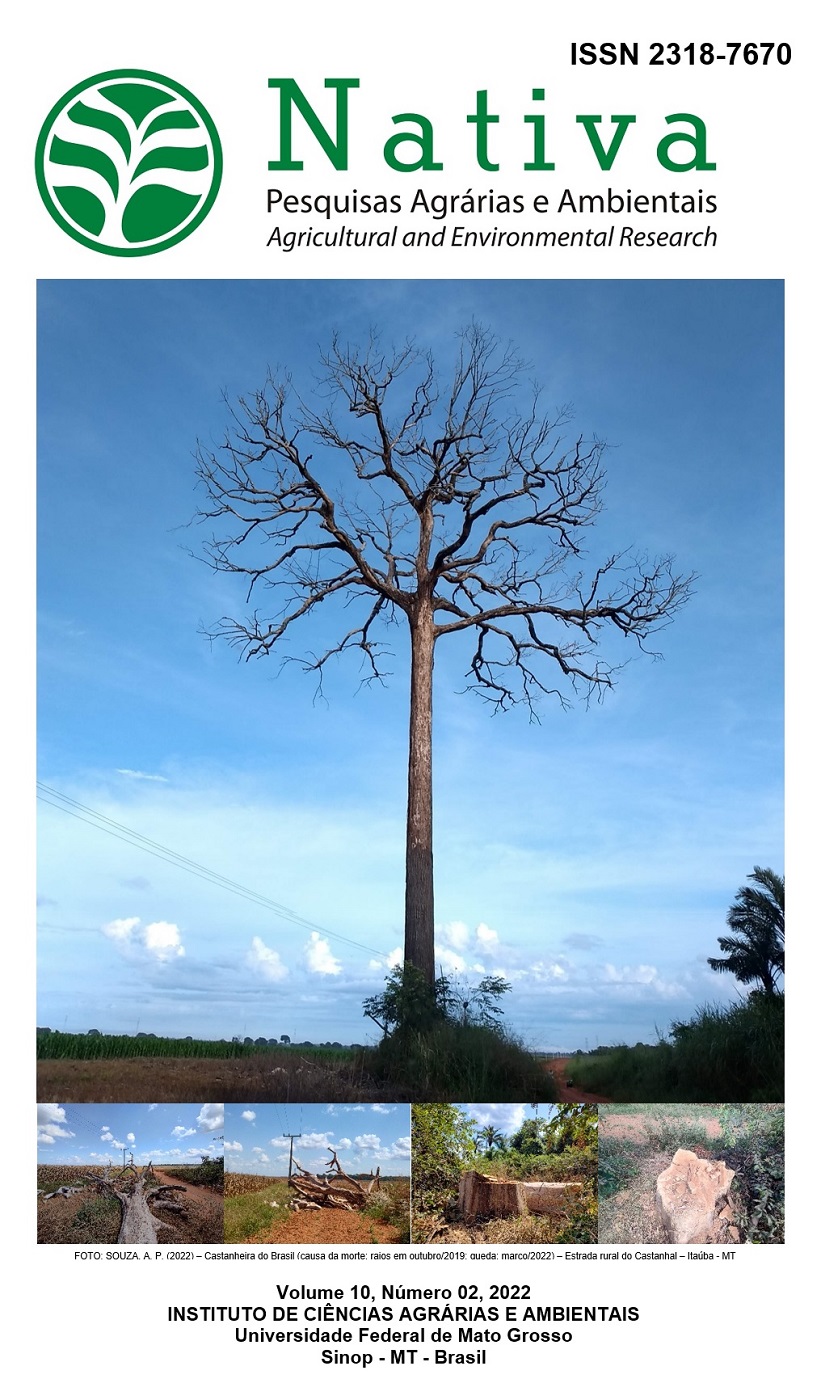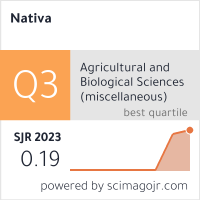MEIOS DE CULTURA PARA CRESCIMENTO E ESPORULAÇÃO DE Choanephora spp. E AVALIAÇÃO DE AGENTES DE CONTROLE BIOLÓGICO IN VITRO
DOI:
https://doi.org/10.31413/nativa.v10i2.12958Palavras-chave:
Fungos conidiais sapróbios, Ellisembia sp., requeima foliar de Choanephora, Pichia sp.Resumo
Choanephora spp. causam podridão floral na cultura do algodão, murcha das folhas na cultura da soja e murcha das folhas, podridão floral e de caule em crotalária. Devido à dificuldade de esporulação deste patógeno em meio de cultivo Batata Dextrose Ágar (BDA), avaliou-se cinco meios de cultura (Batata Doce+BDA, Batata Cenoura Ágar, arroz, aveia e BDA) para desenvolvimento e esporulação de Choanephora spp., e em seguida verificou-se o potencial antagonista de fungos conidiais sapróbios da Amazônia Meridional, Bacillus subtilis, Trichoderma asperellum e Pichia sp. no controle de Choanephora spp. in vitro. De acordo com as análises, os meios de cultura Batata Doce+BDA e Batata Cenoura Ágar apresentaram altas taxas de crescimento micelial e produção de esporos para o isolado de crotalária, e Batata Cenoura Ágar, maiores valores de crescimento e esporos para o isolado de soja. Sendo estes, portanto, os melhores meios para o desenvolvimento in vitro de Choanephora spp. neste estudo. Nos ensaios de antagonismo Ellisembia sp., Brachysporiella sp. e T. asperellum apresentaram maior controle do patógeno, in vitro. Os tratamentos Pichia sp. e Pichia sp.+B. subtilis apresentaram halo de inibição que permaneceu durante 21 dias.
Palavras-chave: Fungos conidiais sapróbios; Ellisembia sp.; requeima foliar de Choanephora; Pichia sp.
Culture media for growth and sporulation of Choanephora spp.
and evaluation of biological control agents in vitro
ABSTRACT: Choanephora spp. affects cotton culture, causes leaf wilt in soybean and leaf wilt, floral and stem rot in crotalaria. Due to the difficulty of sporulation of this pathogen in a medium Potato Dextrose Agar (PDA), were evaluated five culture media (Sweet Potato+PDA, Potato Carrot Agar, Rice, Oats and PDA) for development and sporulation of the pathogen, and the antagonist potential of Saprobic Conidial Fungi from the Southern Amazon, Bacillus subtilis, Trichoderma asperellum and Pichia sp. in the control of Choanephora spp. in vitro. According to the analyzes, the culture media Sweet Potato+PDA and Potato Carrot Agar showed high rates of mycelial growth and spore production for the crotalaria isolate, and Potato Carrot Agar with higher growth values and spores in the soybean isolate. These, therefore, are the best means for the in vitro development of Choanephora spp. in this study. In the antagonism tests Ellisembia sp., Brachysporiella sp. and T. asperellum showed greater control of the pathogen in vitro. The treatments Pichia sp. and Pichia sp.+B. subtilis presented an inhibition halo in some repetitions that lasted for 21 days.
Keywords: Saprobic conidial fungi, Ellisembia sp.; Leaf Blight Choanephora; Pichia sp.
Referências
ALFENAS, R. F.; BONALDO, S. M.; SILVA, R. A. F.; COLARES, M. R. N. First report of Choanephora cucurbitarum on Crotalaria spectabilis: a highly aggressive pathogen causing a flower and stem blight in Brazil. Plant Disease, v. 102, p. 1456, 2018. DOI: https://doi.org/10.1094/PDIS-10-17-1610-PDN
BAGGA, H. S. Fungi associated with cotton boll rot in the Yazoo-Mississippi Delta. Plant Disease Reporter, v. 54, p. 796–798, 1970.
BAUTISTA-ROSALES, P. U.; CALDERON-SANTOYO, M.; SERVÍN-VILLEGAS, R.; OCHOA-ÁLVAREZ, N. A.; RAGAZZO-SÁNCHEZ, J. A. Action mechanisms of the yeast Meyerozyma caribbica for the control of the phytopathogen Colletotrichum gloeosporioides in mangoes. Biological control, v. 65, n. 3, p. 293-301, 2013. DOI: https://doi.org/10.1016/j.biocontrol.2013.03.010
BELL, D. K.; WELLS, H. D.; MARKHAM, C. R. In vitro antagonism of Trichoderma species against six fungal plant pathogens. Phytopathology, v. 72, n. 4, p. 379-382, 1982. DOI: 10.1094/Phyto-72-379.
BETTIOL, W. Impacto potencial das mudanças climáticas sobre o controle biológico de doenças de plantas. Embrapa Meio Ambiente, 2008, cap.18, p. 301-321.
BOTREL, D. A.; LABORDE, M. C. F.; MEDEIROS, F. H. V. D.; RESENDE, M. L. V. D.; RIBEIRO JÚNIO, P. M.; PASCHOLATI, S. F.; GUSMÃO, L. F. P. Saprobic fungi as biocontrol agents of halo blight (Pseudomonas syringae pv. garcae) in coffee clones. Coffee Science, v. 13, n. 3, p. 283-291, 2018. DOI: http://dx.doi.org/10.25186/cs.v13i3.1438
BURGEFF, H. Untersuchungen uber Sexualitat und Parasitismus bei Mucorineen I. Bot. Abh, Alemanha, p. 1-135, 1924.
CAVAGLIERI, L.; ORLANDO, J.; RODRÍGUEZ, M. I.; CHULZE, S.; ETCHEVERRY, M. Biocontrol of Bacillus subtilis against Fusarium verticillioides in vitro and at the maize root level. Research in Microbiology, v. 156, n. 5-6, p. 748-754, 2005. DOI: https://doi.org/10.1016/j.resmic.2005.03.001
CHANDRAKALA, J. Studies on Choanephora twig blight (Choanephora cucurbitarum (berk & rav.) thaxt. of chilli (Capsicum frutescens l.) and its. 2016. 125 f. Tese (Doutorado em Ciências da Agricultura). Professor Jayashankar Telangana State Agricultural University, Rajendranagar, Hyderabad, Telegana.
CUNNINGHAM, D. D. XXIII. On the occurrence of conidial fructification in the Mucorini, illustrated by Choanephora. Transactions of the Linnean Society of London. 2nd Series: Botany, v. 1, p. 409-422, 1879. DOI: https://doi.org/10.1111/j.1095-8339.1879.tb00141.x
GHINI, R. Controle biológico de doenças de plantas: Integração do controle biológico com outros métodos de controle de doenças de plantas. Embrapa Meio Ambiente, 1991, cap.13, p. 201-217.
GOGOI, R.; KULANTHAIVEL, S.; RAI, S. N. AHUJA, D. B. Leaf rot disease of cauliflower caused by Choanephora cucurbitarum in India. Australasian Plant Pathology Society, v. 11, p.27, 2016. DOI: https://doi.org/10.1007/s13314-016-0214-5
GOODAY, G. W. Hormonal control of sexual reproduction in Mucor mucedo. New Phytologist, v. 67, p. 815-821, 1968. DOI: https://doi.org/10.1111/j.1469-8137.1968.tb06397.x
IKEDIUGWU, F. E. O.; EMOGHENE, A. O.; AJIODO, P. O. Biological control of the shoot disease of Amaranthus hybridus caused by Choanephora cucurbitarum with Bacillus subtilis. Journal of horticultural science, v. 69, n. 2, p. 351-356, 1994. DOI: https://doi.org/10.1080/14620316.1994.11516464
JOSHI, M. C. Choanephora cucurbitarum on two new hosts. Note. Indian Phytopathology, 1981.
KUO, C. H.; CHUNG, W. C.; CHANG, C. A. Characterization of the pathogen causing Choanephora wet rot of lima bean in Taiwan. Plant Pathology Bulletin, v. 6, p. 413-418, 1999.
KWON, JIN-HYCUK; JEE, HYCONG-JIN. Soft rot of eggplant (Solarium melongena) caused by Choanephora cucurbitarum in Korea. Mycobiology, v. 33, p. 163-165, 2005. DOI: https://doi.org/10.4489/MYCO.2005.33.3.163
LABORDE, M. C. F.; BOTELHO, D. M. D. S.; RODRIGUEZ, G. A. A.; RESENDE, M. L. V. D.; QUEIROZ, M. V. D.; BATISTA, A. D.; MEDEIROS, F. H. V. D. Phialomyces macrosporus reduces Cercospora coffeicola survival on symptomatic coffee leaves. Coffee Science, v. 14, n. 1, p. 1-11, 2019. DOI: http://dx.doi.org/10.25186/cs.v14i1
LI, S.; CHEN, P.; HARTMAN, G. L. Choanephora Leaf Blight. Compendium of Soja Disease and Pests. 5 ed. American Phytopathological Society Press, Saint Paul, p. 41, 2015.
MANUAL DIFICO. Dehydrated culture media and reagents for microbiology and clinical laboratory procedures. 9 ed. Detroit 1, Michigan, 1984, v. 214, 350p.
NASCIMENTO, S. R. C.; SILVA, F. H. A.; CRUZ, B. L. S.; DANTAS, A. M. M.; AMBRÓSIO, M. M. Q.; SENHOR, R. F. Sobrevivência de estrutura de resistência de Macrophomina phaseolina e Sclerotium rolfsii em solo tratado biologicamente. Revista Agro@mbiente On-line, v. 10, n. 1, p. 50-56, 2016. DOI: http://dx.doi.org/10.18227/1982-8470ragro.v10i1.2947
OLIVEIRA, S. A. B. D.; BARBOSA, F. R.; ANDRADE, E. A.; FERRARINI, S. R.; BONALDO, S. M. Compostos voláteis de fungos conidiais sapróbios da Amazônia Meridional no controle in vitro de fitopatógenos. Summa Phytopathologica, v. 45, n. 3, p. 302-307, 2019. DOI: https://doi.org/10.1590/0100-5405/178478
PARK, J. H; CHO, S. E.; HONG, S. H.; SHIN, H. D. Identification and characterization of Choanephora spp. causing Choanephora flower rot on Hibiscus syriacus. European Journal of Plant Pathology, v. 146, p.1278, 2016. DOI: https://doi.org/10.1007/s10658-016-0972-0
PEREIRA, L.; SILVA, G. S.; RIBEIRO, V. Q. Caracterização fisiológica, cultural e patogênica de diferentes isolados de Lasiodiplodia theobromae. Fitopatologia Brasileira, v. 31, p. 572-578, 2006. DOI: https://doi.org/10.1590/S0100-41582006000600006
ROY, K. W. First Report of Choanephora Leaf Blight of Soybean in Mississippi. Plant Disease, v. 77, n. 12, p. 1262-1262, 1993. Disponível em: <https://www.apsnet.org/publications/plantdisease/backissues/Documents/1993Abstracts/PD_77_1262E.htm>. Acesso em: 14 mar 2019.
SIDDIQUI, Y.; MEON, S.; ISMAIL, M. R.; ALI, A. Trichoderma-fortified compost extracts for the control of Choanephora wet rot in okra production. Crop Protection, v. 27, n. 3-5, p. 385-390, 2008. DOI: https://doi.org/10.1016/j.cropro.2007.07.002
SIDDIQUI, Y.; MEON, S.; ISMAIL, R.; RAHMANI, M. Bio-potential of compost tea from agro-waste to suppress Choanephora cucurbitarum L. the causal pathogen of wet rot of okra. Biological Control, v. 49, n. 1, p. 38-44, 2009. DOI: https://doi.org/10.1016/j.biocontrol.2008.11.008
SOLINO, A. J. S.; OLIVEIRA, J.B.S.; SCHWAN-ESTRADA, K.R.F.; MARIANNA, S. R. A.; RIBEIRO, L. M. Potencial antagonista e controle in vitro de Alternaria solani por fungos sapróbios. Summa Phytopathologica, v. 43, n. 3, p. 199-204, 2017. DOI: https://doi.org/10.1590/1983-21252017v30n429rc
TUITE, J. Plant pathological methods: fungi and bactéria. Minneapolis, 1969. 239p.
TURNER, G. J. Fungi and plant disease in Sarawak. Phyiopathological Papers, v. 13, p. 55, 1971.
VERMA, K. K. “Studies on Choanephora Leaf Blight (Choanephora infundibulifera (Currey sacc.) of soybean (Glycine max (L.) Merrill)”. 2010. 119 f. Tese (Doutorado em ciência na agricultura). Faculdade de Agricultura Indira Gandhi Krishi Kishwavidyalaya, Raipur.
Publicado
Versões
- 2023-10-06 (2)
- 2022-06-03 (1)
Edição
Seção
Como Citar
Licença
Copyright (c) 2022 Nativa

Este trabalho está licenciado sob uma licença Creative Commons Attribution-NonCommercial 4.0 International License.
Direitos Autorais para artigos publicados nesta revista são do autor, com direitos de primeira publicação para a revista. Em virtude de a aparecerem nesta revista de acesso público, os artigos são de uso gratuito, com atribuições próprias, em aplicações educacionais e não-comerciais.
A artigos publicados nessa revista, podem ser reproduzidos parcialmente ou utilizados como referência por outros autores, desde que seja cita a fonte, ou seja, a Revista Nativa.
Copyright for articles published in this journal are the authors, with first publication rights granted to the journal. The journal shows open access, and articles are free to use, with proper attribution, in educational and non-commercial.
The articles published in this journal may be reproduced in part or used as a reference by other authors, provided that the source is quoted.






